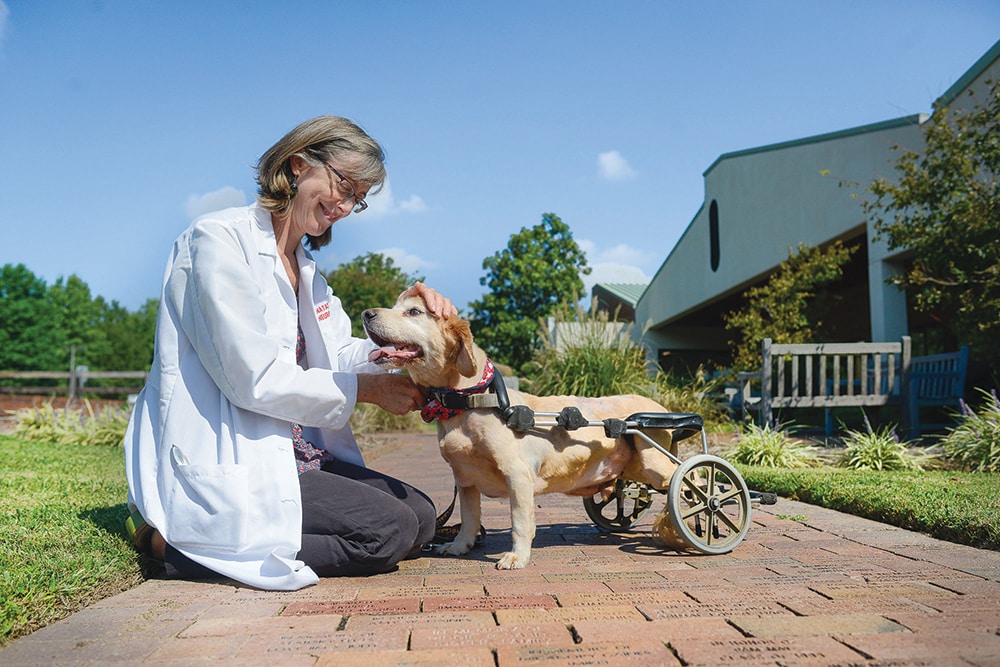Share this Post
Researchers at NC State’s vet school are advancing medicine across the species.
Ed and Ingrid Carney’s rescued German shepherd, Liesel, loves Jeep rides. During one of those rides to the beach, 5-year-old Liesel jumped out of the Jeep and into the sand. She winced and the Carneys noticed her favoring one leg as she walked. Knowing something was wrong, the couple took her to Dr. Warren Gintis, their veterinarian at Swift Creek Animal Hospital in Raleigh.
After a few X-rays, Gintis broke the news that Liesel’s hip was beginning to go bad.
“Given that she was young and reasonably fit, he suggested now would be a good time for a hip replacement,” says Ed Carney, who was referred to Dr. Simon Roe at North Carolina State Veterinary Hospital. “Dr. Roe and the entire staff bent over backwards to make sure that we felt comfortable that we’d get the best care on the planet.”
Roe and his team performed a total replacement of Liesel’s left hip, eliminating her joint pain.
“She had surgery late December and we’re already out doing five mile walks,” says Ed Carney. “She’s the reason I lost 33 pounds! Instead of having a hobbled German shepherd, we’re going to have a dog that’s happy and healthy and is able to have a productive and pain-free life.”
Liesel is just one of more than 182,000 animals that have been helped at North Carolina State Veterinary Hospital since its inception in 1983. One of the highest rated regional academic veterinary medical complexes in the country, the hospital has three medical centers, plus satellite and field operations, with more than 34,000 cases examined, diagnosed, and treated each year.
The Hospital

“The best way to describe our hospital is that it’s like the Mayo Clinic of veterinary medicine,” says Dr. Steve Marks, clinical professor of internal and emergency medicine and the associate dean and director of medical services. “We have a specialty hospital that sees about 35,000 patients a year and it’s a teaching hospital.”
The hospital partners with veterinarians in the community for animal referrals, just like it did with Swift Creek Animal Hospital and Liesel. The process is similar to the human one. If you went to your general practitioner and they thought you were ill, they would send you to a specialist for further examination.
“If they find a lump and they think it’s cancer, they send you to us,” says Marks. “We can do almost any diagnostic and therapeutic procedure you can find in human medicine. We have all the bells and whistles. We can offer what a local vet might not be able to offer.”
The hospital has an ER for emergencies and off-hours, just like a human hospital. If your dog was hit by a car, for example, you could come straight there. Otherwise you would need a referral from your personal veterinarian to be seen. While no one hopes for an illness in their animal, it is nice to know that you and your pet have the resources if needed.
“We’re a state-of-the-art hospital,” says Marks. “We have more specialists in our hospital than any hospital in the country. There are other specialty hospitals in the area, but they aren’t attached to a university.”
The College

The NC State College of Veterinary Medicine (CVM) was the state’s first and only place to study veterinary medicine when it was established in 1978. Now, it boasts 585 faculty and staff members, three departments—Clinical Sciences, Molecular Biomedical, and Population Health and Pathobiology—and an 80-acre farm that serves as the Teaching Animal Unit (TAU). The TAU helps students practice animal husbandry, production management and routine procedures used in livestock production.
Students come into the school with an undergraduate degree in a basic science discipline. Since the school only accepts a class size of 100 each year, with 80 accepted in-state and 20 from outside of North Carolina, competition for admission is tough.
The first three years are primarily pre-clinical years in class and lab training. In the fourth year, students can work in the hospital, which is a mix of teaching and using the hospital as a teaching center. They interact with patients under the supervision of a specialist.
Through interaction, students bridge compassion and science and learn how to provide owners with compassionate medical care while also pushing forward medical innovation.
“We are training veterinarians and veterinary scientists,” says Marks. “It allows us to push the science forward.”
The Research

The university is what makes this hospital unique. At CVM, it’s not only the animals that are being helped. Through education and research, students and staff work to improve the state of medicine for animals as well as humans.
“We’re doing medicine better tomorrow than we’re doing today,” says Dr. Kathryn Meurs, associate dean for research and graduate studies. “We do everything from cancer research to eye research to swine virus research to cell division research and more.”
Ranked the No. 4 College of Veterinary Medicine in the nation by U.S. News and World Report, the CVM houses one of two national centers for the Food Animal Residue Avoidance Databank, which keeps drug residues out of public food supplies.
“I think that what makes the College of Veterinary Medicine unique is this concept that everybody is involved in research,” says Meurs. “Everything we do can provide information that can advance the way we do things.”
The research is broad. Some of it is lab, some is clinical, some benefits animal disease study and some will go on to benefit human disease. Almost all of it is translational research—if you’re doing it in a lab, you want to apply it to a patient somewhere.
“The other aspect where we stand out is this very strong link to biomedical or medical care,” says Meurs. “Some of that really is at the bench. It might be years before it’s going to move to the clinic, but the goal is that these are the things that change healthcare.”
Research is funded through government programs, industry partners, nonprofits or through foundations like the American Heart Association. An experiment that makes discoveries at the cellular level might be funded by the National Science Foundation, while something that’s production animal focused, like how to better vaccinate, might be funded by the U.S. Department of Agriculture.
Current research runs the gamut from eye lesions in sea turtles to treatment approaches for canine vertebral osteosarcoma, the most common bone tumor in dogs.
A Clinical Trial

Ruth Baker’s 10-year-old Pembroke Welsh Corgi, Alex, is nothing short of a champion. In fact, he’s won a grand championship, a masters in agility, and even a Utility Dog Excellent UDX in obedience, a difficult feat, all with his owner by his side.
With such an active dog, Baker was heartbroken when Alex was diagnosed with canine degenerative myelopathy (DM), a neurodegenerative disease parallel to amyotrophic lateral sclerosis (ALS), or Lou Gehrig’s disease, in humans.
“I’m an old person, almost 80,” says Baker. “It’s amazing that I can get out there and run and do agility with my dog. Now I see my best friend have this problem of no longer being able to walk. He hasn’t walked for months.”
Baker and Alex recently entered a clinical trial at NC State that is working to slow down the progression of DM in dogs through a steady dose of a gene-silencer. Since DM is a progressive and fatal disease that affects older dogs, there is no current treatment or cure, just like ALS. By slowing down the disease’s progression, researchers could provide more time.
For Alex, who is also a licensed therapy dog who would visit hospitals, Alzheimer’s patients, and schools, Baker sees this trial as his final way to give back.
“We felt like this was his last contribution to the human world,” Baker says. “And we’re hoping to help human ALS victims as well.”

It Affects Humans Too
Doberman pinschers unfortunately are susceptible to a fatal genetic heart disorder common in their breed, called dilated cardiomyopathy. Basically, the heart muscle’s ability to contract is affected, leading to heart failure or sudden death. Humans who suffer from the same disease also have a grim outcome, with the only current treatment being a total heart transplant. After discovering that human and Doberman cases are caused by the same gene, researchers can test therapies on the dogs on shorter timescales, possibly leading to new and effective human treatment.
Global Health
By merging existing education with global health research, CVM’s new Global Health program has created a multinational effort to combat global health problems. The recipients of the 2019 travel awards are research projects in South Africa, the Galápagos and Senegal.
Pretoria, South Africa— Anthony Blikslager, professor of equine surgery, and Mathew Gerard, professor of anatomy, are working to increase survival rates of injured southern white rhinoceros poached for their horns.
Genovesa Island in the Galápagos— Greg Lewbart, professor of aquatic animal medicine, is studying tourist-induced stress in seabirds, comparing stress hormones in red-footed boobies nestling close to popular tourist areas with those living in quieter parts of the island.
Dakar, Senegal— Research assistant professor Shivaramu Keelara Veerappa aims to stem the tide of infectious diseases transmitted by mosquitoes, including malaria, Zika and yellow fever.
*Information provided by NC State University’s Veterinary Medicine News

fyi. . .
Alex’s trial is not the only clinical trial at NC State. Here are some other projects in the works shaping the future of medicine:
Treatment of Large Skin Tumors in Horses Using High Frequency Irreversible Electroporation
What that means: Through a clinical trial, researchers will use electrical pulses to destroy tumor cells and help chemotherapy penetrate surviving cells. By using high frequency irreversible electroporation, researchers hope to eliminate muscle contractions that are associated with traditional electroporation.
Treating Hypoxia via Tumorally Directed Oxygen for Improving Radiation Therapy
What that means: Dogs diagnosed with soft tissue sarcoma will get oxygen delivered to their tumor tissue during radiation treatment, hopefully increasing tumor response.
*Information provided by NC State Veterinary Medicine
Share this Post








